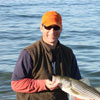Where to Ice Fish
By Tom Keer
Jan 07, 2015
There is a lot more to ice fishing than drilling a hole and setting up shop. Finding a spot is best done when it’s warm out so you can tie in to a species’ winter feeding patterns
There is a lot more to ice fishing than drilling a hole and setting up shop. Finding a spot is best done when it’s warm out so you can tie in to a species’ winter feeding patterns. Let’s break down searching for a spot based on the commonly targeted types of fish.
Yellow Perch: Perch get ice fishermen fired up with good reason. These fish school up, and the schools can be between 10 fish and 100 fish. When a flag flies and a perch is on there is a good chance that everyone else will catch ‘em up. Look for them near weedlines, deadfall, and in a mixture of rocky bottoms and sand/mud that hold insects, scuds, worms, and minnows.
Panfish: Other fish that school in the winter are bluegills, pumpkinseeds, and calico bass. Some of their favorite foods are insects, so they can be found in shallower waters with weedbeds and sandy bottoms. As with the perch, the odds are good that if you find some, you’ll find a lot.
Lake Trout: Ice fishermen like to catch lakers because they run long and fight hard. Most of their winter diets are on baitfish, so you’ll find them around inflows and outflows. They also hunt in areas that makes it easy for them to corral some baitfish (i.e. smelt is a favorite), so they’ll be around rock piles, boulder fields and in the deep water near retaining walls. They can be in shallow or deep water, so if you’ve marked structure at 40 feet in the summer, it’s a good option in the winter.
Bass: Look for smallmouth bass in deeper waters at the 30-50 foot mark. They’ll prefer rocky areas. Smallies sometimes move into shallower water unlike the largemouths that prefer to stay in shallower water. Look for bucketmouths in areas that have lots of weeds and soft bottoms.
Yellow Perch: Perch get ice fishermen fired up with good reason. These fish school up, and the schools can be between 10 fish and 100 fish. When a flag flies and a perch is on there is a good chance that everyone else will catch ‘em up. Look for them near weedlines, deadfall, and in a mixture of rocky bottoms and sand/mud that hold insects, scuds, worms, and minnows.
Panfish: Other fish that school in the winter are bluegills, pumpkinseeds, and calico bass. Some of their favorite foods are insects, so they can be found in shallower waters with weedbeds and sandy bottoms. As with the perch, the odds are good that if you find some, you’ll find a lot.
Lake Trout: Ice fishermen like to catch lakers because they run long and fight hard. Most of their winter diets are on baitfish, so you’ll find them around inflows and outflows. They also hunt in areas that makes it easy for them to corral some baitfish (i.e. smelt is a favorite), so they’ll be around rock piles, boulder fields and in the deep water near retaining walls. They can be in shallow or deep water, so if you’ve marked structure at 40 feet in the summer, it’s a good option in the winter.
Bass: Look for smallmouth bass in deeper waters at the 30-50 foot mark. They’ll prefer rocky areas. Smallies sometimes move into shallower water unlike the largemouths that prefer to stay in shallower water. Look for bucketmouths in areas that have lots of weeds and soft bottoms.
Popular Posts









